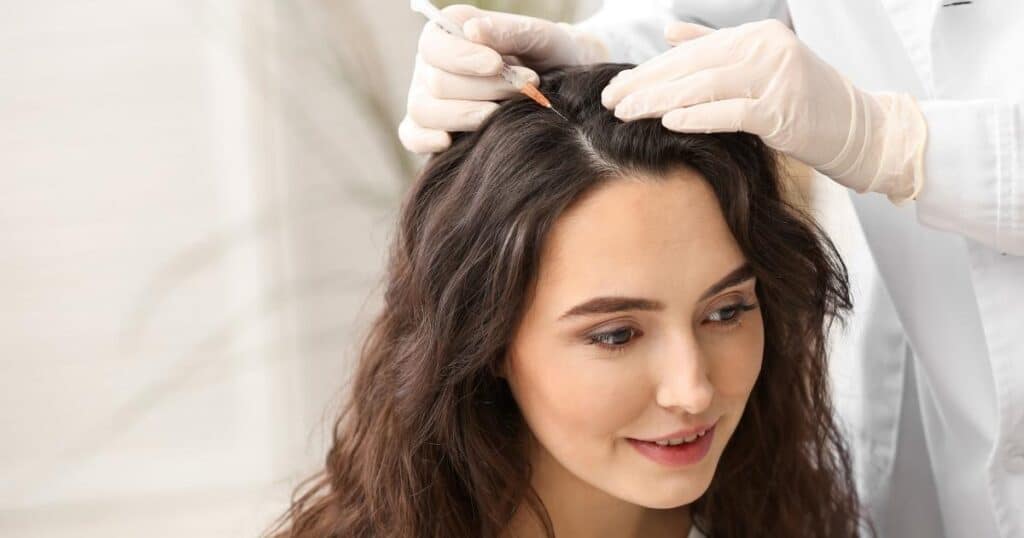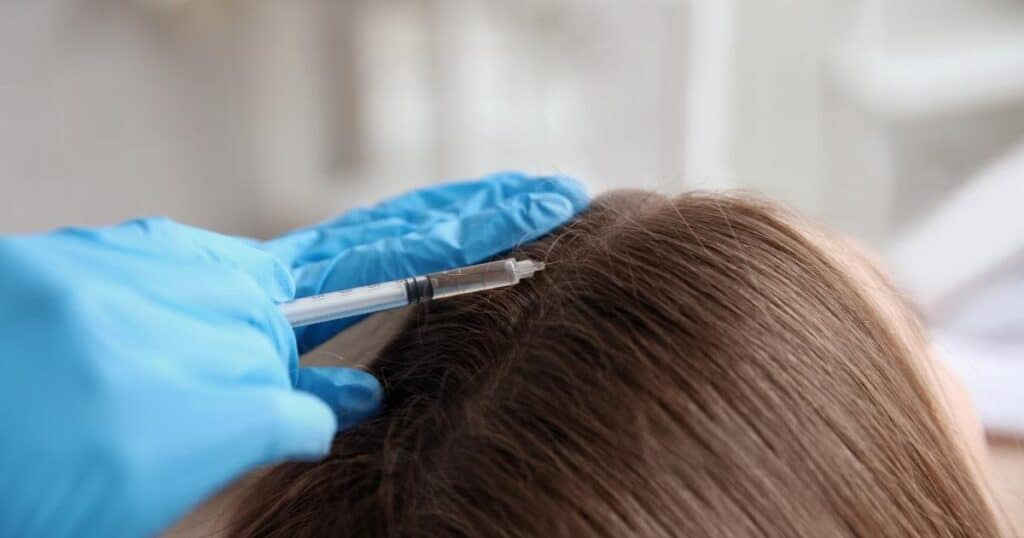Female hair loss can be an emotionally challenging journey, but it doesn’t have to spell the end of your locks. For many women suffering from thinning or balding due to genetics, aging, or medical conditions, a woman hair transplant may be an effective solution.
In this blog post, we’ll explore what a woman hair transplant entails from understanding if you’re eligible for the procedure to the potential costs and risks involved. Read on to learn more about how female-specific transplants could help restore your confidence in your appearance.
Table of Contents:
- What is a Hair Transplant?
- Who Can Get a Hair Transplant?
- What is Involved in the Procedure?
- Cost and Risks of a Hair Transplant for Women
- FAQs about Woman Hair Transplant
- Conclusion
Understanding Hair Transplant Surgery
Hair transplant involves harvesting healthy follicles from one part of the scalp and transferring them to another area to address baldness or thinness due to genetics or age. The transplanted hairs will grow like regular hair, making it an effective solution for permanent hair loss.
What is a Hair Transplant?
A hair transplant is a medical procedure where healthy donor hairs are taken from one area of the head and relocated to another part where there is balding or thinning due to genetic factors or age-related changes.
Definition of Hair Transplant:
A hair transplant is a medical procedure in which healthy donor hairs are taken from one area of the head and relocated to another part where there is balding or thinning due to genetic factors or age-related changes. The goal of this procedure is to restore natural-looking fullness and coverage in affected areas with results lasting up to 10 years depending on individual lifestyle choices such as diet, exercise, sun exposure, etc.
Two main hair transplant techniques are Follicular Unit Extraction (FUE) and Follicular Unit Strip Surgery (FUSS), both of which involve harvesting donor hairs from the back or sides of the head for grafting onto thinning areas. Both procedures involve harvesting donor hairs from a healthier area at the back or sides of the head before they are grafted onto thinning areas using either tiny incisions made with special tools (FUE) or strips removed from larger sections cut out from these same areas (FUSS). Your physician may suggest one method over the other, depending on how much coverage is desired, based on their knowledge and proficiency.
Main Hair Transplant Techniques
Two primary hair transplant techniques are Follicular Unit Extraction (FUE) and Follicular Unit Strip Surgery (FUSS). Both involve harvesting donor hairs from the back or sides of the head for grafting onto thinning areas. Your physician may suggest one method based on their knowledge and proficiency.
| Follicular Unit Extraction (FUE) | Follicular Unit Strip Surgery (FUSS) | |
| Procedure | Individual follicles are extracted using a small punch device. | A strip of the scalp is removed and then dissected into individual follicular units. |
| Scarring | Minimal scarring, with tiny dot scars that are typically not noticeable. | Linear scar in the area where the strip of the scalp was removed. |
| Recovery Time | is Generally shorter as it’s less invasive, often just a few days. | Longer, usually around 2 weeks, due to the need for sutures/stitches. |
| Pain Level | Typically less painful due to the minimally invasive nature of the procedure. | It can be more painful due to the surgical removal of a strip of scalp. |
| Suitability | Suitable for patients who wish to keep their hair short as scars are less visible. | Often recommended for those who need many grafts and do not plan to wear their hair very short. |
| Number of Grafts | Typically, fewer grafts are transplanted at one time compared to FUSS. | Allows for a larger number of grafts to be transplanted at one time. |
Benefits of Hair Transplants:

The benefits of hair transplants are manifold:
- Natural-Looking Results: Hair transplants offer a more natural and realistic appearance compared to other hair loss treatments. This can significantly boost the patient’s self-confidence.
- Long-Lasting Solution: A successful hair transplant offers a permanent solution to hair loss. Unlike other treatments that may require ongoing use, once the transplanted hairs take root, they will grow naturally.
Quick Recovery Time: After hair transplant surgery, recovery time is generally short. Most patients can return to regular activities swiftly without taking too much time away from work or other interests.
Risks of Hair Transplants
While hair transplants come with several benefits, there are also risks to be aware of:
- Scarring: Although modern techniques minimize this risk, there may still be scarring depending on the specific procedure used and the patient’s response to healing.
- Infection: As with any surgical procedure, there’s a risk of infection. Proper post-operative care can minimize this risk.
- Shock Loss: This temporary hair loss condition can occur after the procedure. It typically resolves itself as the scalp heals.
- Numbness: Some patients experience temporary numbness in the treated area. This usually subsides after a few weeks.
- Unsatisfactory Results: There’s a risk that the hair transplant may not meet the patient’s expectations. This could be due to various factors, including poor hair density, unnatural look, or uneven hair growth. Having realistic expectations and choosing a qualified and experienced surgeon is important.
Who Can Get a Hair Transplant?

Hair transplantation is an effective solution for many, but certain criteria determine its success and suitability for individuals.
Qualifications for a Hair Transplant:
The ideal candidate for a hair transplant should have healthy scalp skin, enough donor hair to cover the balding areas, and realistic expectations about the procedure. Those in good physical health and not taking medications that could interfere with healing are usually considered good candidates.
Age Requirements for a Hair Transplant:
Patients are generally recommended to wait until they’re at least 25 years old before undergoing the procedure, ensuring their natural pattern of hair loss is well established.
The Rise of Female Hair Transplants: Understanding Unique Challenges and Opportunities
Women increasingly turn to hair transplants, accounting for a growing percentage of those seeking this solution yearly. According to a study, women comprised 15.3% of hair transplant patients in 2019. It is crucial to recognize that women often experience different types of hair loss than men due to hormonal differences.
Female-patterned baldness typically manifests as thinning across the entire head rather than in localized patches, as seen in male-patterned baldness. This pattern can make it more challenging for surgeons to achieve successful results with female hair transplants than with male ones. Women who meet the age requirements and have sufficient donor hair qualify for a hair transplant. Next, we’ll delve into the specific details of the hair transplant procedure.
Rise of Female Hair Transplants Worldwide
| Year | Percentage of Female Hair Transplants |
| 2015 | 12.5% |
| 2016 | 13.2% |
| 2017 | 13.9% |
| 2018 | 14.4% |
| 2019 | 15.3% |
| 2020 | 16.1% |
| 2021 | 17.0% |
The Hair Transplant Procedure

A medical technique that involves moving hair follicles from a donor area to a recipient site, aiming to restore or enhance hair density in thinning or balding regions.
What is Involved in the Procedure?
Preparation for the Procedure:
Before undergoing a hair transplant, it’s important to consult with a qualified doctor or surgeon. The patient’s medical history and current health are considered during this consultation, and any questions or concerns are addressed.
The Process of the Procedure:
Hair transplants typically involves local anesthesia, harvesting healthy follicles from donor sites on the scalp, and then transferring them to balding areas. Post-operative instructions, such as refraining from strenuous activity and protecting the scalp from sunburns, are crucial for a successful result.
Cost of a Hair Transplant for Women
The average cost of a female hair transplant ranges between $6,000 and $15,000, depending on various factors. Here’s a table detailing the factors that can affect the cost of a female hair transplant:
| Factors | Description |
| Geographical Location | The cost can vary based on where the clinic is located. Higher costs of living often translate to higher procedure costs. |
| Surgeon’s Experience | More experienced surgeons often charge more for their expertise. |
| Technique Used | The cost can vary depending on whether the Follicular Unit Extraction (FUE) or Follicular Unit Strip Surgery (FUSS) technique is used. |
| The extent of Hair Loss | The amount of hair loss and the number of grafts required can significantly affect the cost. More extensive hair loss usually means more grafts are needed, which increases the cost. |
| Post-Procedure Care | Aftercare medication, special shampoos, or follow-up visits may add to the cost. |
| Additional Procedures | If additional procedures are required for optimal results, such as PRP (Platelet-Rich Plasma) treatment, this will increase the cost. |
| Travel Costs | If the clinic is located out-of-town, travel and accommodation costs should also be considered. |
Key Takeaways
- Hair transplants are a highly effective and long-lasting solution for permanent hair loss.
- The two main types of procedures – FUE and FUSS – offer quick recovery times without any risk or scarring.
- Women considering a hair transplant should seek advice from a specialist to determine the most suitable treatment option.
- Proper care and maintenance can provide long-lasting results from a hair transplant.
Are you tired of struggling with hair loss? Don’t let it hold you back any longer. Take the first step towards restoring your confidence and reclaiming your youthful appearance. Visit Hair Transplants Los Angeles today, where our highly skilled and experienced professionals will guide you through your journey towards fuller, natural-looking hair. Don’t wait; schedule an appointment now and start your transformation today. Your hair, your confidence, your life – it’s time to reclaim them all!
FAQs about Woman Hair Transplant
Is hair transplant successful in females?
Yes, hair transplants can be successful in females. The success of a hair transplant for women may vary depending on various elements, including the source of balding and the patient’s overall health. Hair transplants are typically more successful in female patients when they have good donor areas with healthy follicles that can be harvested and transplanted to balding or thinning areas. With proper care after surgery, results from a female hair transplant procedure can last for many years.
How long does a female hair transplant last?
A female hair transplant can last a lifetime if properly maintained. The transplanted follicles are taken from the donor. Then they’re relocated to areas of baldness or thinning, where they continue to grow just like natural hair. With proper care such as avoiding direct sun exposure, and using protective styling techniques, these transplanted hairs can remain healthy for many years with minimal shedding.
Can hair transplant cure female pattern baldness?
Yes, hair transplants treat female pattern baldness. The procedure involves harvesting healthy follicles from the back & sides of the scalp. Then, placeing onto areas with thinning or balding patches. This treatment can assist in the reconstruction of a natural-looking hairline for those who have experienced baldness due to hereditary or other causes.
Results vary depending on individual cases. However, overall it is an effective solution for many people suffering from female pattern baldness.
How can a woman hide her hair transplant?
Women can hide their hair transplant by using a variety of methods. For example, they use hats or scarves to cover the transplant area. They may also choose to style their existing hair in such a way that it conceals the newly-transplanted hairs. Hair extensions are another option for women who want more coverage and natural-looking results from their transplant procedure.
Finally, some women opt for hairstyles like bobs or pixies. Why? This helps them camouflage any signs of having undergone a hair restoration treatment.
Is a Woman Hair Transplant Right for You?
A hair transplant is a great solution for women who are looking to restore their thinning or balding areas. Though costly and with potential risks, hair transplants are usually safe when administered by a professional. Women should seek the advice of a specialist before making a decision on whether this treatment is suitable for them. With proper care and maintenance, woman’s hair transplants can provide long-lasting results that help you look your best.
Take control of your hair loss today and discover the best solution for you with a woman’s hair transplant. Our experienced team will provide you with the highest quality service to restore your confidence and look
Best Hair Transplant
1970 S. Prospect Ave., Suite 2
Redondo Beach, CA 90277
(213) 403-0455
https://www.google.com/maps?cid=9280610872186794918.
To ensure your ease of mind, you can view our customer recommendations HERE. Furthermore, you can also see our Google reviews and Yelp reviews. We can’t wait to help you start restoring your lost hair.
